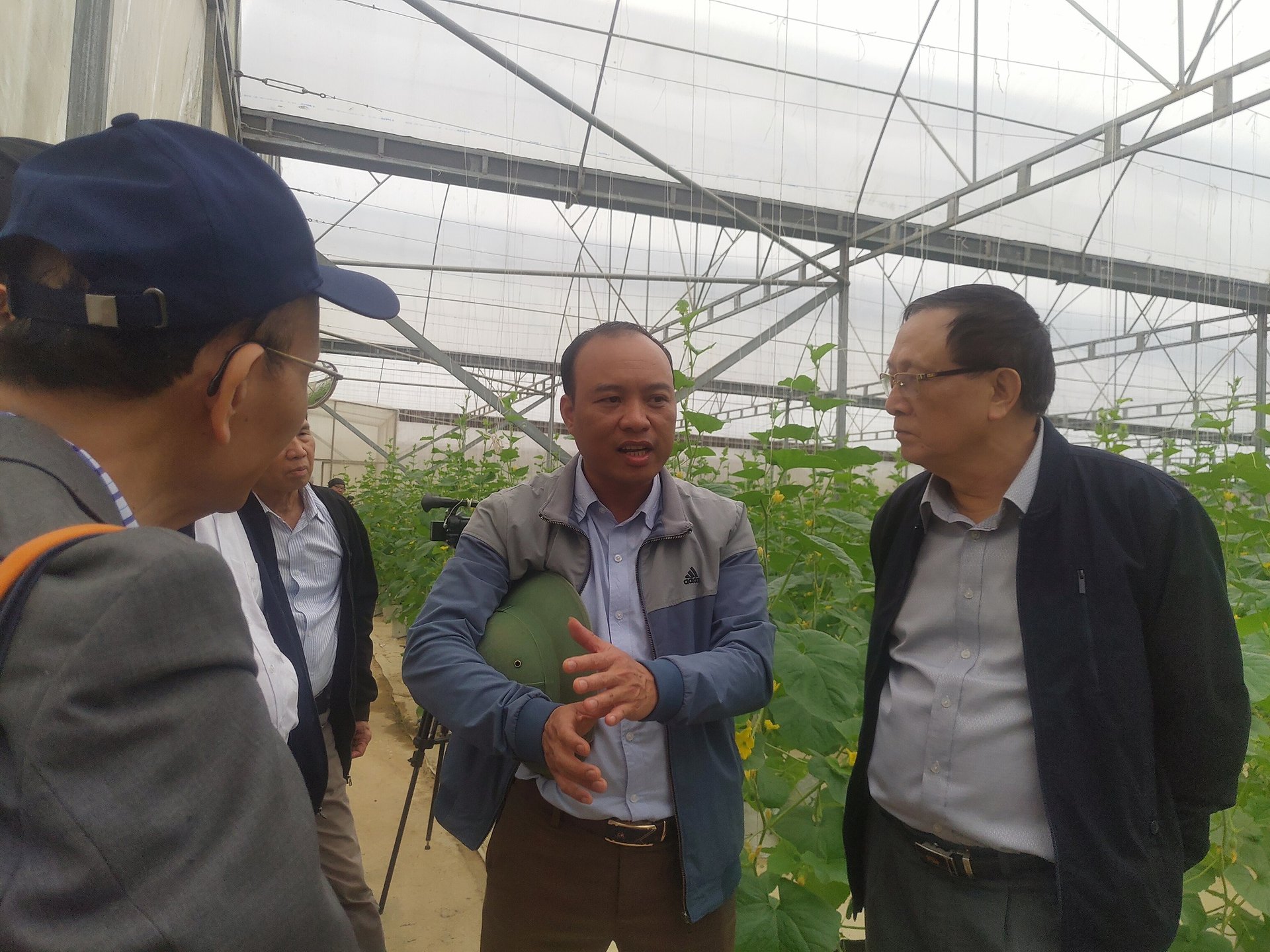November 28, 2025 | 00:18 GMT +7
November 28, 2025 | 00:18 GMT +7
Hotline: 0913.378.918
November 28, 2025 | 00:18 GMT +7
Hotline: 0913.378.918

The team of journalists visited the orchid garden.
The place where Nguyen Xuan Hai, Vice Chairman of the People's Committee of Tho Xuan district, and Thang, the agriculture staff of Tho Xuan district, brought us to was the "houses" of orchids. Moth orchids were grown in these houses, each plant had its own pot, neatly placed on green shelves.
Agricultural engineer Le Huy Khiem, Director of Lam Son Hi-tech Agricultural Research and Development Center Co., Ltd (a member of Lasuco), said that the center had 20 gardens, 0.8 -1 ha wide each. 20 different orchid varieties was being grown here. The high-tech orchid farming structure has been implemented by the center since 2016.

The officer of the Department of Agriculture provides guidance to journalists.
“So how is it considered high-tech?”, I asked. “Breed, ie tissue is number 1; then comes the care, nutrition for orchids, flower sprout differentiation. Each orchid root, from transplanting to flowering, must be moved up to 3 times”, Khiem said and added that the temperature in each "orchid house" during the day must be maintained at 20oC and 18 - 20oC at night. Moss and grass in the orchid pots were all imported. Thanks to proper care, the number of plants that do not flower is only 1%.
According to Engineer Khiem, every year the center provides the market with 50,000 pots, the revenue from orchids reaches VND 10 billion/year. Even so, the output has not met the market demand. The center is maintaining both wholesale and retail distribution. Since transporting flowers is a very difficult job, the center's workers frequently help customers and arrange flower pots according to their wishes.

Nethouse growing cantaloupe.
Lacuso’s official name is Lam Son Sugar Cane Joint Stock Corporation. In 2013, under the leadership of Hero of Labor Le Van Tam, also Chairman of the Board of Directors of Lasuco, Lam Son Hi-tech Agriculture Center was put into operation.
The center’s function is to cooperate and link with domestic and foreign scientific and technological organizations, research and apply advanced technologies, implement science and technology projects, transfer and consult new technical designs for growers.
The center covers an area of 124 ha, has 33 nethouses and greenhouses applying Israeli technology which directly produce high-quality flowers, vegetables, tubers and fruits. The total investment capital is approximately VND 300 billion.
Khiem said that in order to produce high-quality products, the center has applied artificial intelligence (AI) to analyze the optimal farming process, respond to weather changes in each farming area and alert the technical board to adjust accordingly.
Standing in a nethouse growing cantaloupe, Khiem pointed at the automatic feeding system. “All information is integrated over time. The production manager at the Production Coordination Center will base on factual information and make forecasts. Harvesting and transporting also utilize high technology, coordinating vehicles on the map without congestion, wrong route or delay”.
The application of these technological solutions helps the center solve the difficulties in the production process, making precise forecasts of the output next year to plan accordingly, and most importantly, reducing production costs.
Since the application of high technology, the center has not only produced disease-free and high-quality sugarcane varieties, meeting the needs of building a sustainable raw material area for the processing industry but also provided seedless, disease-free orange varieties to the market. The center annually produces more than 300 tons of high-grade and safe vegetables such as cantaloupe, cherry tomatoes, bell peppers to supply to the market.
The center ensures safe production, and the effects are evident. Khiem said, “1 ha of cantaloupe only needs to go through two crops to reap the profits, no need to worry about the output market at present. 33 nethouses, but only 43 workers are needed. The pay is also good, VND 10 million/month on average. In the cantaloupe gardens, the center also combines beekeeping for honey”.
On the way back to Thanh Hoa city, I suddenly thought of Hero of Labor Le Van Tam. It was he who "woke up" the whole western land of Thanh Hoa, creating jobs for thousands of local workers. Lam Son Hi-tech Agricultural Research and Development Center Co., Ltd is innovating day by day, becoming one of the most modern production facilities in Vietnam from breeding, cultivation to preservation in the age of green agriculture.
Translated by Samuel Pham

(VAN) According to Mr. Vo Minh Thanh, Director of the Tay Ninh Department of Agriculture and Environment, Resolution 57 has created a new development pathway for the locality, shifting from traditional toward modern agriculture.
/2025/11/26/4909-2-154329_878.jpg)
(VAN) Pearl grouper farming in HDPE cages not only delivers economic efficiency but also contributes to protecting the environment, creating jobs, and promoting marine-based experiential tourism.

(VAN) The model of making a living under the forest canopy through the agroforestry system in Van Son commune, Bac Ninh province, is expected to generate an annual income of approximately VND 30 million/ha.

(VAN) Many enterprises in Can Tho are harnessing natural energy and reducing greenhouse gas emissions in their production processes, thereby contributing to the promotion of a sustainable green transition.
/2025/11/24/3536-2-112800_176.jpg)
(VAN) Dong Nai now has tens of thousands of hectares of forests certified for sustainable management, and this area will continue to be expanded in the coming period.

(VAN) Vinh Ha hamlet (Dai Xuyen commune, Hanoi) is shifting away from small-scale farming as households adopt bioscurity into their breeder chicken models.

(VAN) Heavy rains make aquatic species more vulnerable to disease. Proactive water management and high-tech systems help farmers prevent outbreaks and protect yields.